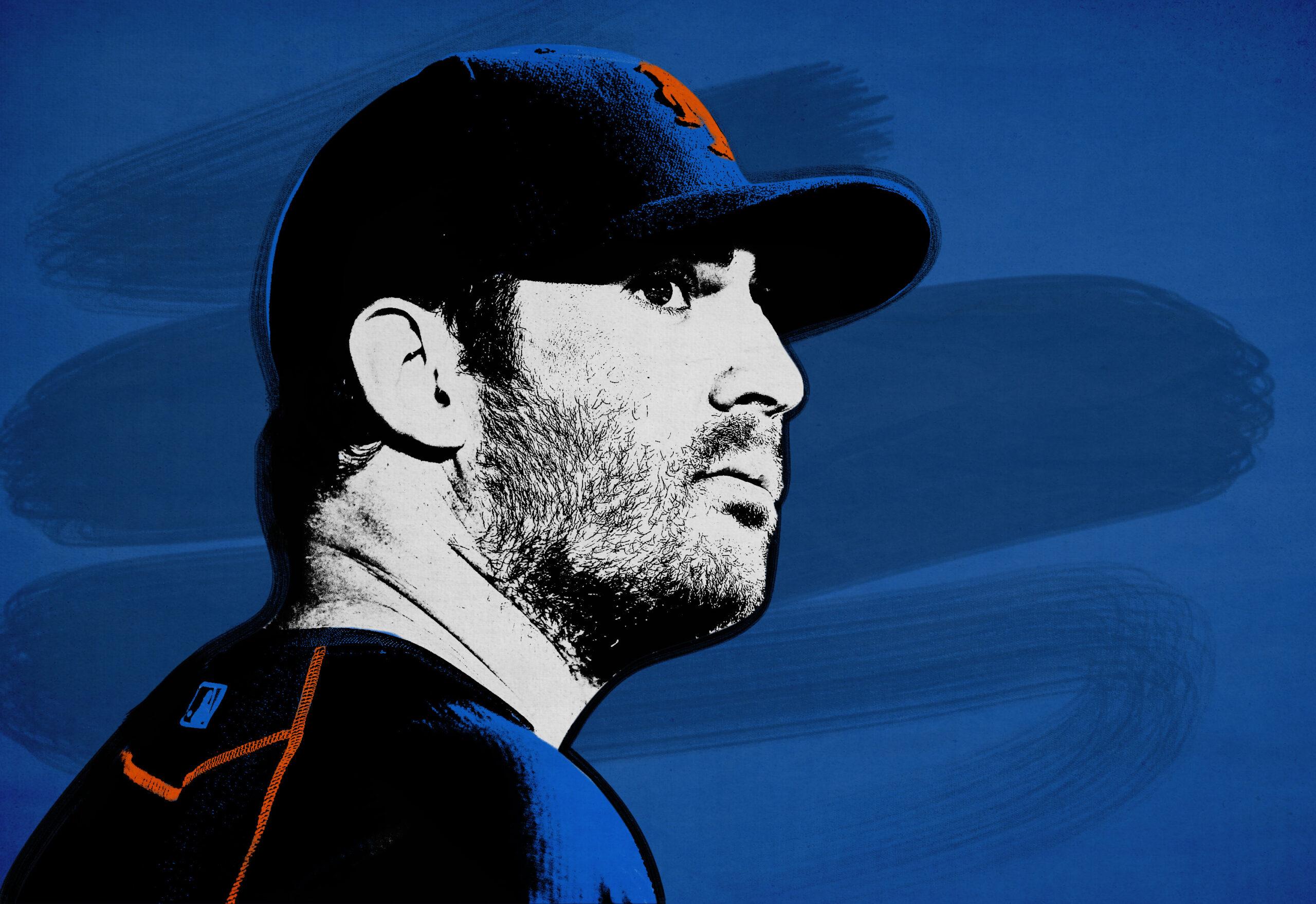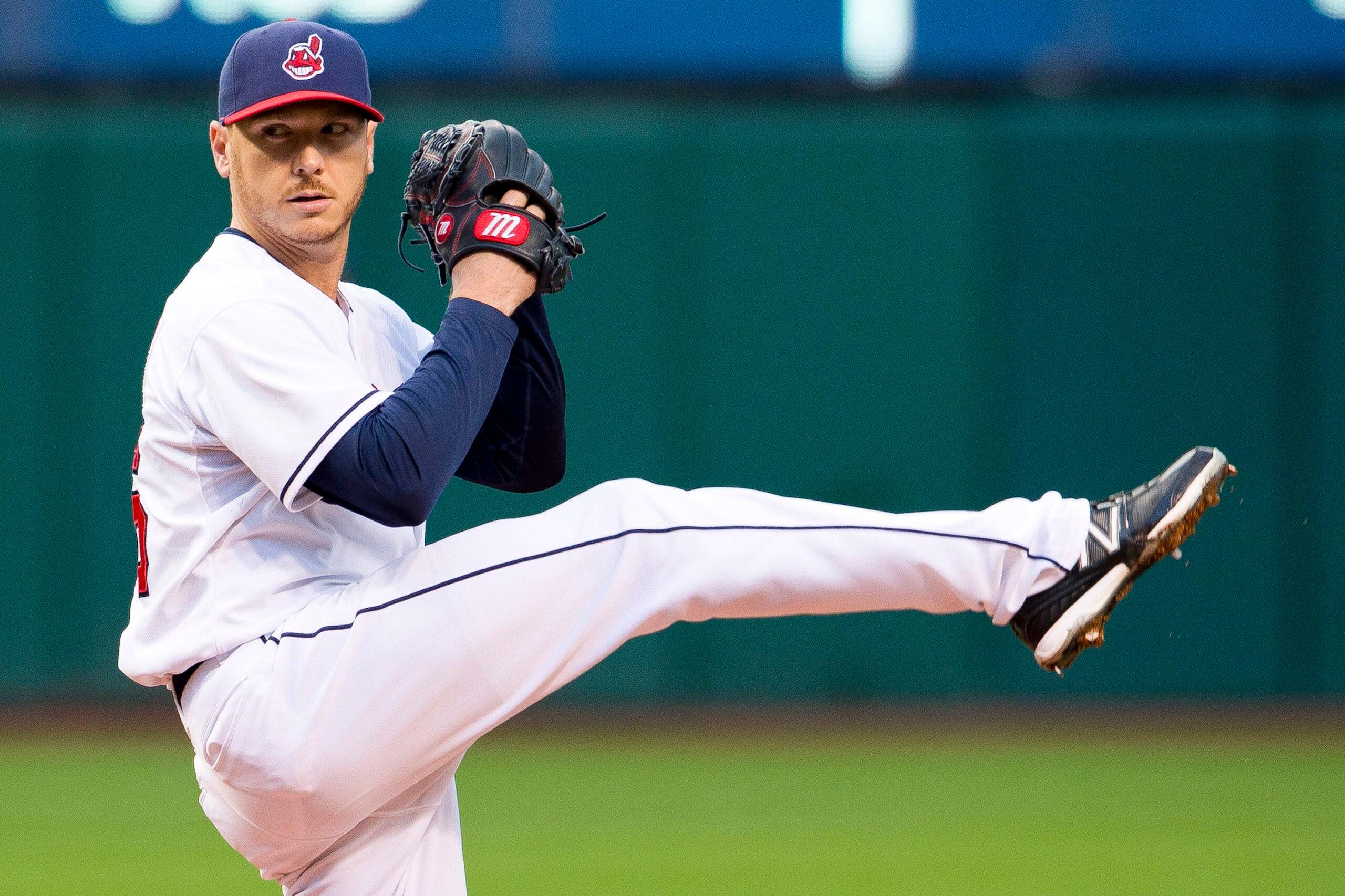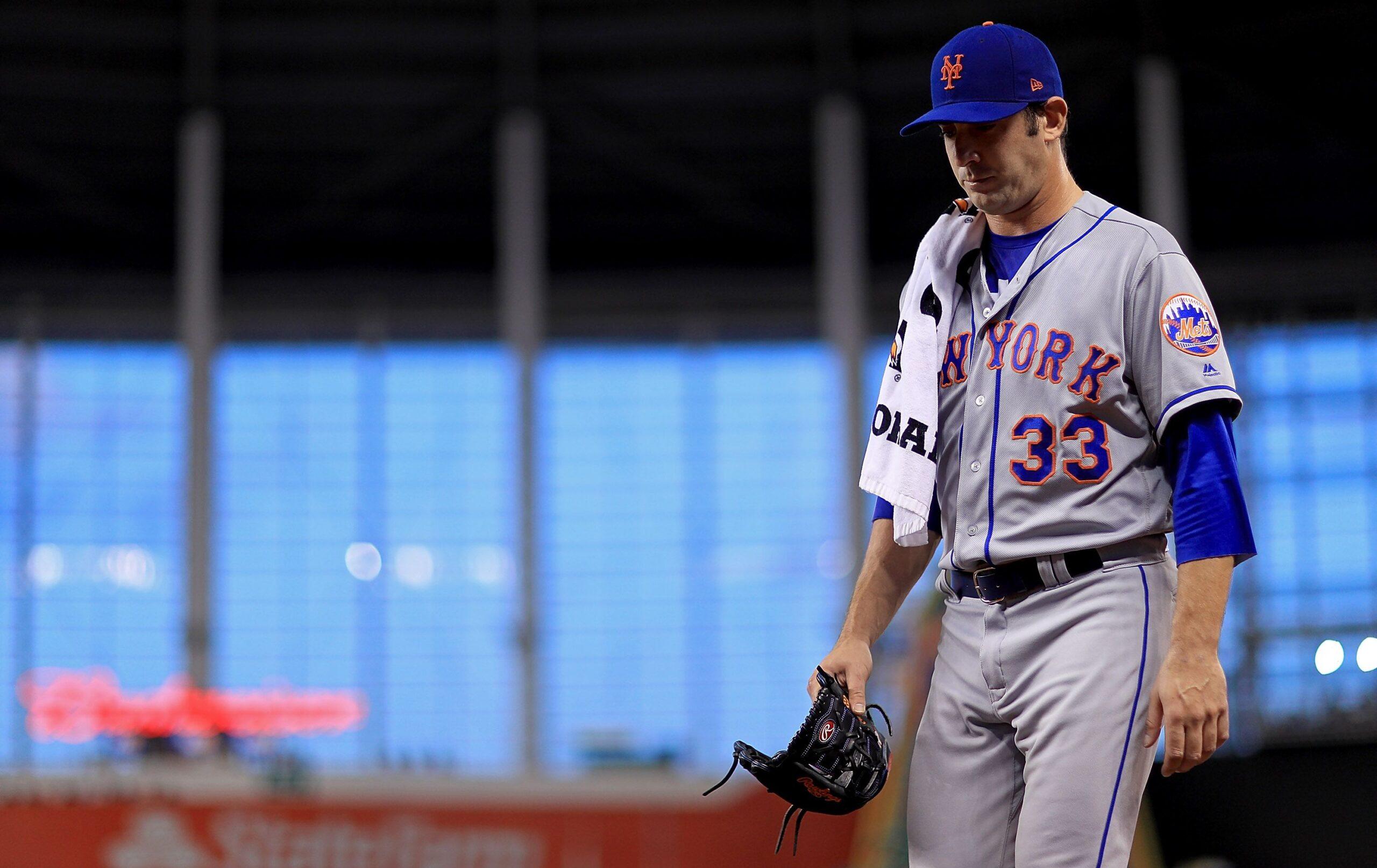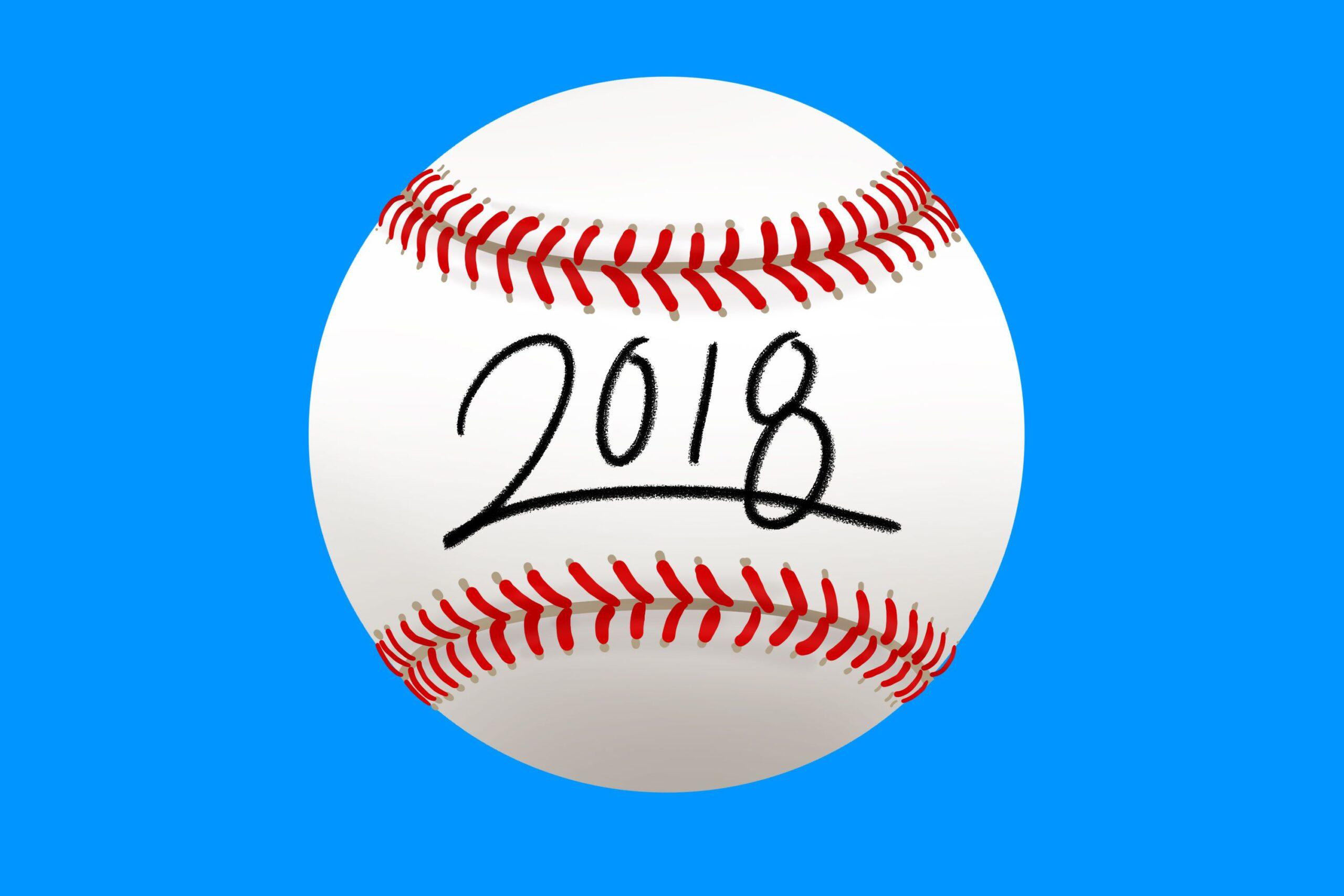
There was a time in the distant past when the New York Mets entered the season with five starting pitchers, age 28 or younger, who’d appeared in the top 25 of a Baseball Prospectus prospect list and at least shown flashes of making good on that promise in the bigs. Five hotshot young starters, plus a sixth, Jacob deGrom, who’d developed late and turned in a 137 ERA+ on an average of 25 starts over his first three seasons.
It was a time in the distant past when the Mets had so many talented starters that even with Generation K in living memory, MLB marketed deGrom, Noah Syndergaard, Matt Harvey, and Steven Matz as the Four Horsemen of Queens.
It’s hard to believe that distant past was only 12 months ago.
In 2018, Matz looks less and less likely to ever throw 160 innings in a season. Syndergaard missed almost all of last year with a torn lat muscle. Zack Wheeler’s made just 17 big league starts since 2014. Robert Gsellman might not be a starter at all. DeGrom, the rock of the rotation, is battling back issues.
And Harvey, once the crown jewel of this Xanadu for power pitchers, might be washed.
The second-coolest thing about the Four Horsemen and their confrères is how much of their potential stemmed not from natural ability or amateur hype, but from professional player development. Gsellman was a 13th-rounder who learned a slider and started throwing in the mid-90s in 2016. Syndergaard was a pudgy mid-major position player recruit who She’s All That-ed into the 38th overall pick in 2010. After the Mets traded for him, he developed the best stuff of any pitching prospect, perhaps in the history of baseball. And deGrom was a college infielder who went in the ninth round after pitching for only one season. Now he’s pretty much Zack Greinke with better hair.
The coolest thing about the Mets’ young pitchers, however, was Harvey.
The no. 7 overall pick out of North Carolina in 2010, Harvey required less development than some of his teammates—a little over two years after he was drafted, his fastball hit 99 miles an hour against the Diamondbacks in his major league debut. A year after that, he put on a pair of orange spikes and started the All-Star Game in his home ballpark.
While most baseball players go to great lengths to cultivate boring celebrity personas, Harvey had an NBA player’s understanding that fame isn’t something you can shed once you leave the ballpark. He attended Fashion Week, dated (and ultimately went to pieces after being dumped by) supermodel Adriana Lima, and let The New York Times into his apartment. He embraced celebrity in a way that made him look like the new Doc Gooden for a Mets team on the rise. People started calling him the Dark Knight, which was a corny nickname that doesn’t quite fit with Batman canon, but it meant that Harvey had reached a level of notoriety that warranted a citywide sobriquet.
And he backed it up on the mound. Of all the Mets’ celebrated starters, Harvey owns the best single-season ERA+ (157) and highest Cy Young finish (fourth). Where the gigantic Syndergaard was powerful, Harvey was punchy. Where the long-limbed deGrom was graceful, Harvey was brutally elegant. Harvey didn’t quite look his listed height of 6-foot-4, thanks to a thick build and drop-and-drive delivery, two attributes—along with his big fastball and hellacious breaking ball—that he shared with the late José Fernández.
Harvey was so dazzling because he was among the first of a brand of starting pitchers that has since become the norm. In 2013, the height of Harveymania, Fernández made his big league debut. Max Scherzer made his first All-Star team; Yu Darvish nearly threw a perfect game in his first start. Chris Sale finally convinced people that his arm wasn’t destined to explode at the elbow. Then came Corey Kluber, and Syndergaard, and Harvey was suddenly no longer the golden child but one of many pitchers in a class.
Harvey missed all of 2014 after having Tommy John surgery, which is routine these days, and about half of 2016 after having surgery to correct thoracic outlet syndrome, which isn’t routine. That procedure involved having his first rib removed to alleviate compression on the nerves and blood vessels in his throwing shoulder, and Harvey hasn’t been the same pitcher since.
Rock bottom came at some point in 2017, either when the Mets suspended him for calling in sick after he was out until 4 a.m. reportedly hoping to run into Lima at a New York nightclub, or when he went on the DL with a broken scapula, or when he came back in September looked like a sad facsimile of himself. That month, his fastball averaged 94 miles per hour, down from a peak average velocity of 97.6 in July 2013.
The Mets, well out of the pennant race by that point, would have been better off rooting around for some indy-league cannon fodder to eat those last six September appearances, not only because Harvey’s celebrity magnifies his own failures, but because some anonymous junkballer legitimately might have fared better. Opponents hit .422/.487/.637 against Harvey, who struck out 13 in 22 1/3 innings, while walking 12 and allowing 28 runs, all earned.
That ignominious month was the capper on a season that looks unfathomably bad, considering the highs Harvey once achieved—and not just before Tommy John. He was outstanding in 2015, up until the last game of the World Series, where his eight scoreless innings might have gone down as a career-defining clutch performance had manager Terry Collins not sent Harvey back out for the ninth, when he and closer Jeurys Familia blew a 2-0 lead and sent the game to extra innings. The Royals won the game, and the series, in the 12th. It’s hard to reconcile that Harvey with the Harvey who played for the Mets last year, even with the knowledge that Harvey has a pretty serious injury history.
Since 2000, 53 individual starting pitchers in their 20s had seasons in which they threw at least 90 innings and posted an ERA+ of 70 or worse. (Edinson Vólquez did it twice, bless his heart.) That list is, as you might expect, full of pitchers who never got another serious shot in the big leagues, but it’s not all bad news. Jake Arrieta had a 68 ERA+ in 114 2/3 innings in 2012, then won a Cy Young with the Cubs after escaping the charnel house that is the Orioles’ pitcher development program. Jeanmar Gómez, Darren Oliver, and Óliver Pérez all reinvented themselves as relievers and had respectable second acts. Even Vólquez returned to put up very good back-to-back seasons in 2014 and 2015, totaling almost 400 innings with a 118 ERA+ between them, and winning a World Series against Harvey’s Mets in the process. Joel Pineiro, Ryan Vogelsong, and Colby Lewis all evolved and had late-career comebacks, even though Lewis had to go all the way to Japan to find himself. Ryan Dempster was an All-Star as a starter with the Marlins at age 23, spent his mid-20s bouncing from bullpen to DL before re-emerging as the Cubs’ closer, and eventually returning to the rotation. He ended his career with six straight seasons of 170 innings or more, over which he posted a 110 ERA+ and a K/9 ratio of 8.2.
As for the bad news: Tim Lincecum’s on that list. He’s still trying to come back. Sidney Ponson was never the same, nor was Mark Mulder or 2002 NL Rookie of the Year Jason Jennings. The closest thing to a positive precedent for Harvey is Scott Kazmir, who was also a first-round pick (famously of the Mets), and emerged as one of the game’s best power pitchers a little more than a decade ago.
Kazmir was an All-Star in 2006 at the age of 22, won the AL strikeout title at age 23, and returned to the All-Star Game in 2008 as the face of the rebranded Tampa Bay Rays. Like Harvey in 2015, Kazmir led his club to the pennant and started games 1 and 5 of a five-game World Series loss.
Then he went to pieces. Kazmir battled a strained quad in 2009, and when the Rays traded him to the Angels that August, his ERA was approaching 6.00. While he pitched well down the stretch for Anaheim that year, Kazmir pitched through shoulder injuries in 2010, then his back gave out and limited him to just 14 big league batters faced in the next two seasons.

But after two years in the wilderness—some of it spent literally in the wilderness as he sought the guidance of Texas-based pitching guru Ron Wolforth—Kazmir returned to the big leagues in 2013 with the Cleveland Indians. (Kazmir’s pitching coach in Cleveland, Mickey Callaway, is Harvey’s manager now.) And for two and a half years, he was very good. Not quite as good as he was in his youth, but from 2013 to 2015, Kazmir averaged 31 starts and 177 innings a year, with a 108 ERA+, and even made another All-Star team in 2014. That’s easily no. 3, maybe even no. 2 starter territory.
But it took a lot of time and coaching attention for Kazmir to recover. And as beat up as Kazmir’s body was, he never had to deal with thoracic outlet syndrome.
Familiarity breeds comfort with injuries, even scary ones. We know what to expect when a pitcher has a torn rotator cuff or tears his ACL. When Syndergaard goes on the shelf with a lat strain, we can point to that muscle on our own bodies and remember spending a weekend in bed after a misadventure while moving a TV set. “Tommy John surgery” is a positively friendly moniker for a medical procedure that keeps pitchers out of action for more than a year.
But there’s something alien about “thoracic outlet.” It sounds like the thing R2-D2 plugs into to recharge. We don’t usually think of humans as even having a thorax—that’s the middle part of an insect, according to what we learned in elementary school.
But Harvey, like the biblical Adam, is nevertheless now short a rib. (Unlike in Adam’s case, that rib was not used to create a woman, no doubt to Harvey’s immense disappointment.) Scary as Harvey’s injury is, it isn’t unprecedented.
Many thoracic outlet syndrome comeback attempts fail because the pitcher in question was either not that good to start with or at the end of his rope anyway. Chris Carpenter in 2012 and Josh Beckett in 2013 probably wouldn’t have lasted much longer even without a thoracic outlet syndrome diagnosis, and while Mike Adams threw just 43 2/3 innings in the big leagues after he went down with thoracic outlet syndrome in late 2012, his career ended at age 35.
Perhaps the most famous case of thoracic outlet syndrome was Astros right-hander J.R. Richard’s. Entering his age-30 season in 1980, Richard was coming off back-to-back 300-strikeout seasons and top-five Cy Young finishes. In mid-July, he had a 1.90 ERA and a 9.4 K/9, easily besting teammate Nolan Ryan’s numbers, when TOS-related arterial constriction caused a career-ending stroke that could have killed him.
However, more recent examples give more cause for hope. Jaime García posted a 143 ERA+ in 163 1/3 innings in 2010—if he hadn’t come into the league with Jason Heyward and Buster Posey, he would’ve likely won Rookie of the Year. After losing half of 2014 to thoracic outlet syndrome, García returned a year later. He hasn’t been as good as he was his rookie year, but a 104 ERA+ on an average of 26 starts and 153 innings a year isn’t terrible.
Braves righty Mike Foltynewicz underwent surgery for thoracic outlet syndrome in September 2015, two weeks before he turned 24. At the time of the surgery, he’d spent a year and change in the big leagues and posted a career ERA of 5.64. But by the next May, he was back in the big leagues, and since then he’s been a reliable back-end starter, with a 4.58 ERA in 277 1/3 innings over two seasons.
Former Rangers lefty Matt Harrison was traded from Atlanta to Texas in 2007, along with Neftalí Feliz, Elvis Andrus, Jarrod Saltalamacchia, and Beau Jones, in exchange for Mark Teixeira and Ron Mahay. Harrison made his big league debut in 2008, and lost the second half of 2009 to thoracic outlet syndrome in his throwing shoulder. He returned to the big leagues in 2010, pitching mostly out of the bullpen, and in 2011 he posted a 130 ERA+ in 185 2/3 innings and made two starts in the World Series. In 2012, Harrison had a 133 ERA+ in 213 1/3 innings. But he made no more than four starts in each of the next three seasons, thanks to recurring back injuries and surgery to alleviate thoracic outlet syndrome in his other shoulder. Harrison was sent to Philadelphia as a salary makeweight in the Cole Hamels trade in 2015, eight years to the day after he was traded for Teixeira, and is now enjoying his retirement.
So it’s not unheard of for pitchers to come back from thoracic outlet syndrome, and apart from Richard, who was pitching in a time in which sports medicine was unrecognizably primitive, none of the pitchers who came back to pitch effectively were as good pre-surgery as Harvey.

But it’s important to weigh those factors against two negatives. The first is that even pitchers who throw up a stinker of a season like Harvey’s 2017 and then return to be effective starters haven’t lasted that long. Harrison got hurt again after just two years, while Foltynewicz and García are pretty much back-of-the-rotation guys now.
The second is that while some pitchers come back from thoracic outlet syndrome, it’s still pretty much a career-ender for others. Padres right-hander Tyson Ross hasn’t pitched effectively in the big leagues since he had his rib removed. Nor has Phil Hughes, who needed a second surgery last year. The jury’s still out on two Royals: veteran Nathan Karns and former no. 5 overall pick Kyle Zimmer. Maybe Harvey pitched like crap last year because the physical ability he showed from 2012 to 2015 just isn’t there anymore.
Neither is the pitcher he was early in his career, in all likelihood, though there’s a lot of ground between “not as good as Prime Matt Harvey” and “out of baseball.” One of Harvey’s biggest problems last year—perhaps the biggest—was a loss of command and control. The book on Harvey at his best was always about power, but he also had exceptional command and control. Harvey’s walk rate last year was 10.9 percent, up from 4.5 percent in 2013. That would’ve been dead last in baseball if he’d had enough innings to qualify. That made his opponent swing rate crash, particularly on pitches out of the zone, and his strikeout rate plummeted as a result.
Let’s say that Harvey’s velocity—sitting 92-94 mph in spring training, though most pitchers take a while to build velocity this early in the year—is never going back to the 96-97 range he showed at his peak. But let’s say that with a fully healed scapula, an offseason to refocus, and Callaway in his corner, Harvey regains his command and control. That pitcher isn’t a top-five Cy Young vote-getter, particularly because throwing 94 isn’t as impressive as it was even in 2013. But there’s room for a pitcher like that in just about any rotation in baseball, particularly now that rotations have to go more than five deep. Or maybe Harvey ends up in the bullpen.
The performance- and injury-related markers Harvey’s showed the past two years mean that a return to his ace-level pre-injury form would require an unprecedented recovery. It’s a shame for the Mets and their fans, as well as for Harvey, who’s a free agent after this season and will likely never cash in with a much-speculated-about nine-figure deal. This isn’t certainly the end of the road, but at the very least, it’s a change of destination.
